Welcome to the Kodak AZ401 manual, your comprehensive guide to mastering this versatile digital camera. This manual provides detailed instructions, tips, and troubleshooting to help you unlock its full potential.
Overview of the Kodak AZ401 Camera
The Kodak AZ401 is a budget-friendly digital camera designed for photographers seeking versatility and ease of use. It features a 40x optical zoom, ideal for capturing distant subjects, and offers manual mode for creative control. The camera is equipped with scene modes tailored for specific conditions, ensuring optimal results in various lighting environments. While its image quality may not excel in all scenarios, the AZ401 remains a practical choice for casual photographers. The manual provides essential guidance for navigating its features, troubleshooting common issues, and maximizing its potential. This guide is indispensable for users aiming to make the most of their AZ401 experience.
Importance of Reading the Manual
Importance of Reading the Manual
Reading the Kodak AZ401 manual is essential for understanding its features, settings, and optimal use. The manual provides detailed instructions on navigating the camera’s interface, customizing settings, and troubleshooting common issues. It serves as a comprehensive guide to unlocking the camera’s full potential, ensuring you make the most of its capabilities. By familiarizing yourself with the manual, you can avoid costly mistakes, improve image quality, and enhance your overall photography experience. Whether you’re a novice or an experienced photographer, the manual offers valuable insights to help you master the AZ401 and achieve professional-grade results.
Key Features of the Kodak AZ401
The Kodak AZ401 stands out with its impressive 40x optical zoom, making it ideal for capturing distant subjects with clarity. Priced at $169.99, it offers excellent value for budget-conscious photographers. The camera features a 16.1MP CCD sensor, ensuring detailed images, and supports 720p video recording. Its 3-inch LCD screen allows for easy previewing and navigation. While it may not excel in image quality, its affordability and robust feature set make it a popular choice. The manual highlights these features, guiding users to optimize their photography experience and make the most of the AZ401’s capabilities.
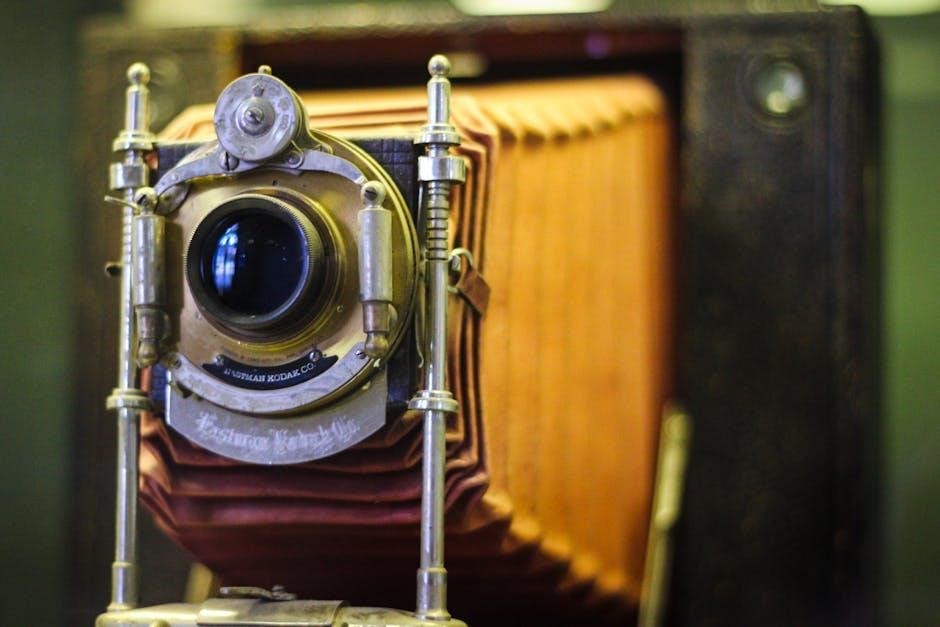
Setting Up Your Kodak AZ401
Setting up your Kodak AZ401 involves unboxing, initial inspection, installing the battery and memory card, charging, and navigating the setup menu for optimal functionality.
Unboxing and Initial Inspection
When you unbox your Kodak AZ401, carefully inspect the contents, including the camera, lens cap, shoulder strap, battery, charger, and manual. Ensure all items are undamaged and accounted for. Perform an initial inspection of the camera body, lens, and LCD screen for any visible scratches or defects. Check the battery compartment and memory card slot for proper alignment and functionality. Familiarize yourself with the camera’s exterior controls, such as the mode dial, zoom lever, and shutter button. Reading the manual during this step will help you understand the camera’s layout and features, ensuring a smooth setup process.
Installing the Battery and Memory Card
To power up your Kodak AZ401, start by installing the supplied lithium-ion battery. Open the battery compartment, usually located on the bottom of the camera, by sliding it open. Insert the battery with the terminals facing the correct direction, as indicated by the icons inside the compartment. Gently push until it clicks securely into place. Next, insert a compatible memory card (SD, SDHC, or SDXC) into the card slot, typically located on the side of the camera. Ensure the card is properly formatted and compatible with the AZ401 for optimal performance. Close both compartments firmly to secure the battery and memory card in place.
Charging the Battery
To charge the Kodak AZ401 battery, use the provided USB cable and charger. Connect the cable to the camera’s USB port, located on the side or bottom, depending on the model. Plug the other end into a compatible charger or a powered USB port. The battery level indicator will turn red while charging and change to green when fully charged. Allow 2-3 hours for a complete charge. Avoid overcharging, as it may reduce battery life. Always use the original charger to ensure safety and compatibility. Once charged, the battery provides sufficient power for extended use. Check the battery level via the LCD screen to monitor remaining power.
Navigating the Initial Setup Menu
When you first turn on the Kodak AZ401, you’ll be prompted to navigate the initial setup menu. Start by selecting your preferred language using the navigation buttons. Next, set the date and time, ensuring accuracy for proper file naming and timestamping. You may also be asked to configure image quality settings or shooting modes. Use the OK button to confirm selections and the back button to revisit previous options. The menu is intuitive, with clear prompts guiding you through the process. Once completed, your camera will be ready for use. Refer to the manual for detailed explanations of each setup option to optimize your camera’s performance.
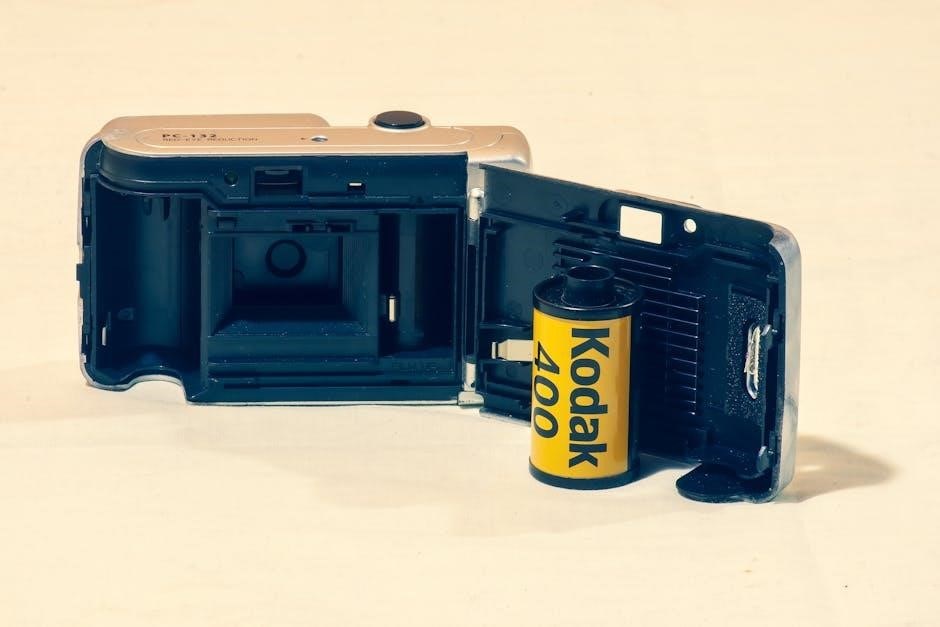
Understanding the Camera Modes
The Kodak AZ401 offers multiple shooting modes, including Auto, Manual, and Scene modes, each designed for different photography needs and skill levels to enhance creativity and control.
Auto Mode: Point and Shoot
Auto Mode is the simplest way to capture stunning images with the Kodak AZ401. Designed for beginners and quick shots, this mode automates settings like aperture, shutter speed, and ISO, ensuring well-balanced photos in various lighting conditions. The camera automatically detects the scene and adjusts settings accordingly, making it ideal for everyday use. Features like face detection and image enhancement are also enabled to improve portrait and landscape shots. To use Auto Mode, simply turn the mode dial to the “Auto” position and let the camera handle the rest. This mode is perfect for those who want to focus on composition without worrying about manual adjustments, delivering great results with minimal effort.
Manual Mode: Customizing Your Settings
Manual Mode on the Kodak AZ401 offers complete control over camera settings, allowing photographers to fine-tune aperture, shutter speed, and ISO to achieve their creative vision. This mode is ideal for advanced users who want precision in their shots. To access Manual Mode, turn the mode dial to “M” and adjust settings using the control dials or menu. Aperture control lets you regulate depth of field, while shutter speed adjustments enable artistic effects like motion blur or freezing action. ISO settings can be optimized for lighting conditions to minimize noise. Use the LCD screen to preview adjustments in real time. Experiment with different combinations to master Manual Mode and unlock the camera’s full potential for unique and professional-looking photos.
Scene Modes: Tailored for Specific Conditions
Scene Modes on the Kodak AZ401 are designed to optimize camera settings for specific shooting scenarios, ensuring the best results without manual adjustments. The camera offers modes like Portrait, Landscape, Sports, and Night, each tailored to particular conditions. Portrait Mode focuses on subject sharpness and softens backgrounds, while Landscape Mode emphasizes depth and clarity for scenic shots. Sports Mode freezes fast-moving subjects, and Night Mode captures low-light scenes with reduced noise. Selecting the right Scene Mode adapts the camera’s settings, such as aperture, shutter speed, and ISO, to match the situation. This feature is ideal for photographers who want professional-looking photos without complex adjustments, making it user-friendly and efficient for various environments;
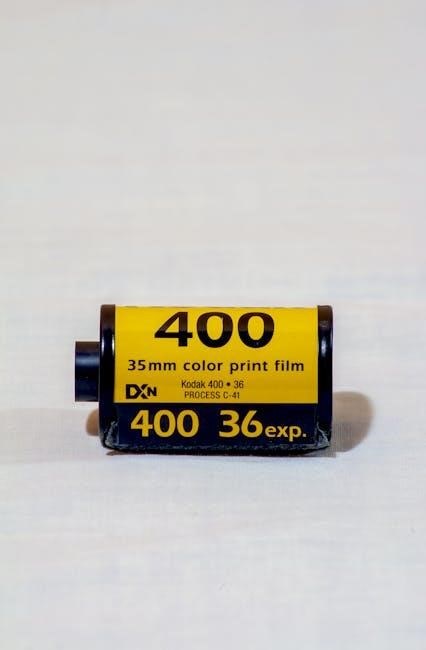
Photography Basics with the AZ401
Master the fundamentals of photography with the Kodak AZ401, exploring essential concepts like exposure, ISO, composition, and lighting to capture stunning images effortlessly.
Understanding Exposure: Aperture, Shutter Speed, ISO
Exposure is the foundation of photography, balancing light through aperture, shutter speed, and ISO. Aperture, measured in f-stops, controls light entry and depth of field. A lower f-stop (like f/2.8) opens wider, letting in more light and blurring backgrounds, while a higher f-stop (like f/16) narrows the aperture, sharpening more of the image. Shutter speed, in seconds, freezes or blurs motion; faster speeds (1/1000th of a second) capture sharp action, while slower speeds (1 second) create artistic blur. ISO adjusts sensitivity; lower ISOs (100) excel in bright light, minimizing noise, while higher ISOs (6400) handle low light but may introduce grain. Balancing these elements is key to optimal image quality with the Kodak AZ401.
Mastering ISO Settings for Optimal Image Quality
ISO settings on the Kodak AZ401 control the camera’s sensitivity to light, directly impacting image quality. Lower ISO values (100-400) are ideal for bright lighting, producing sharp, noise-free images. Higher ISOs (6400-12800) amplify sensitivity, useful in low-light conditions, but may introduce digital noise. To master ISO, start with the lowest possible setting and adjust as needed. Pair ISO with aperture and shutter speed for balanced exposure. Avoid extreme ISOs unless necessary, as they can degrade image quality. Experiment with ISO settings to find the right balance for your shooting environment, ensuring crisp and detailed photos every time with the AZ401.
White Balance: Capturing Accurate Colors
White balance on the Kodak AZ401 ensures accurate color representation by adjusting the camera’s interpretation of light sources. Auto White Balance (AWB) automatically detects and adjusts based on the scene. For more control, use presets like Daylight, Tungsten, Fluorescent, or Cloudy to match lighting conditions. Custom White Balance allows setting a specific color temperature (K) for precise results. Use a white or gray card to measure accurate colors. Incorrect white balance can result in unwanted color casts, while correct settings enhance realism and professional-grade imagery. Experiment with different modes to achieve natural tones, especially in mixed lighting scenarios, ensuring vibrant and true-to-life photos with the AZ401.
Focusing Techniques: Ensuring Sharp Images
Mastering focusing techniques is essential for capturing sharp, clear images with the Kodak AZ401. The camera offers multiple focus modes, including Single AF, Continuous AF, and Manual Focus. Use Single AF for stationary subjects and Continuous AF for moving objects. To ensure precise focus, use the center focus point, as it is the most accurate. Position the focus point on your subject using the directional buttons, then press the shutter button halfway to lock focus. For optimal results, ensure your subject is well-lit and avoid using the smallest aperture settings. Manual Focus allows for creative control, ideal for macro or portrait photography. Regularly cleaning the lens and sensor also improves focus accuracy. By mastering these techniques, you can achieve sharp, professional-looking images every time.
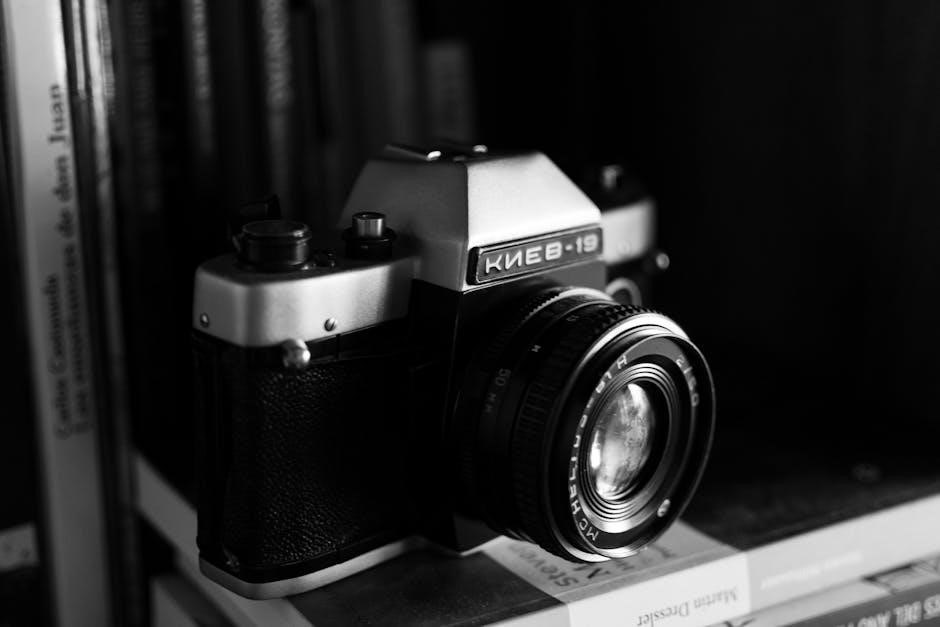
Utilizing the 40x Optical Zoom
The Kodak AZ401’s 40x optical zoom delivers exceptional versatility, capturing distant subjects with clarity. Ideal for wildlife, sports, or landscapes, it empowers photographers to frame shots precisely. Use a tripod for stability at maximum zoom to avoid blur and ensure sharp images. Experiment with angles and focus on details to enhance composition. This feature makes it easy to explore creative possibilities, elevating your photography to new levels.
Maximizing the Zoom Feature
To maximize the Kodak AZ401’s 40x optical zoom, ensure the camera is stable, using a tripod for sharper images at higher zoom levels. Experiment with framing to capture dynamic compositions. Shoot in well-lit conditions to maintain image quality, as low light can degrade clarity at maximum zoom. Avoid over-relying on digital zoom, as it may soften details. Take your time to compose shots, focusing on distant subjects like wildlife or landmarks. This feature enhances creativity, allowing you to capture intricate details from afar. By mastering the zoom, you can achieve professional-grade results and unlock new possibilities in your photography.
Image Stabilization: Reducing Camera Shake
Image stabilization is a vital feature of the Kodak AZ401, designed to minimize camera shake and blur, especially when using the 40x optical zoom. This technology helps produce sharper images by compensating for hand movement or low-light conditions. Enable image stabilization in the camera settings to ensure clearer results. For optimal performance, use a tripod to enhance stability further. Regularly clean the lens and ensure proper camera maintenance to maximize the effectiveness of this feature. Image stabilization is particularly useful for handheld photography, reducing the need for a tripod in many situations. It ensures your photos remain crisp and vibrant, even at maximum zoom levels.
Best Practices for Zoom Photography
For exceptional zoom photography with the Kodak AZ401, hold the camera steadily using both hands and consider using the viewfinder for better stability. A tripod is recommended, especially at maximum 40x zoom, to prevent blur. Start with a wide-angle shot to frame your subject, then gradually zoom in. Avoid sudden movements while zooming to maintain focus. Ensure good lighting, as low light can reduce image clarity at high zoom levels. Use the zoom ring smoothly for precise control. Finally, review your images on the LCD screen and adjust settings if needed for optimal results. These practices will help you capture sharp, detailed photos even at extreme distances.
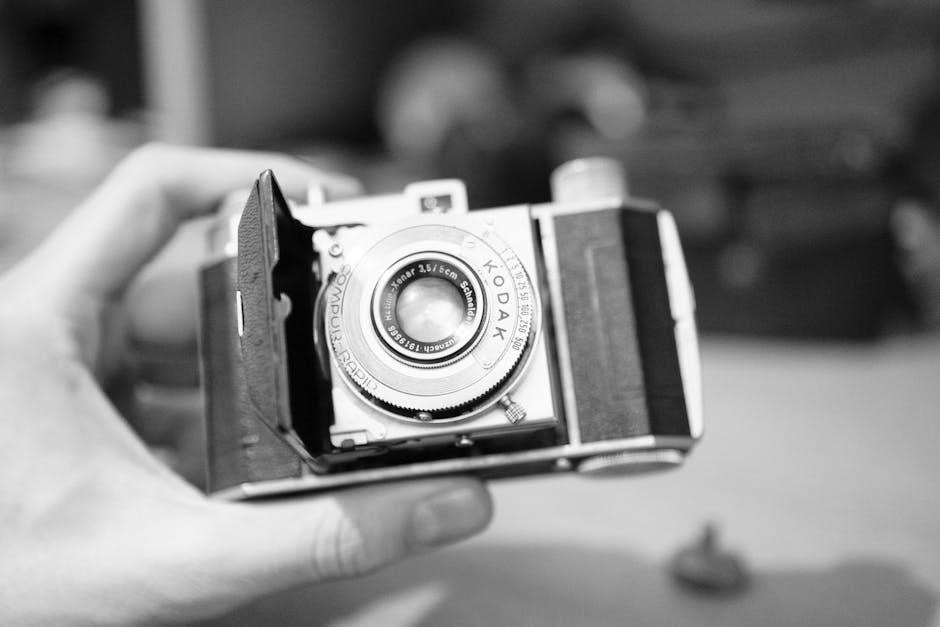
Image Quality and Settings
Adjust settings like resolution and compression to optimize image clarity and detail. Balance quality with storage needs for stunning photos every time, effortlessly.
Adjusting Image Resolution and Compression
The Kodak AZ401 allows you to adjust image resolution to balance quality and storage. Choose from multiple settings, such as 16MP, 12MP, or lower, depending on your needs. Higher resolution captures more detail but increases file size, while lower resolution is ideal for sharing or saving space. Compression settings, like Fine or Standard, also impact image quality and file size. Fine compression retains more detail, making it suitable for professional use, while Standard compression reduces file size, which is practical for everyday photography. Experiment with these settings to find the perfect balance between quality and convenience for your photos.
Understanding RAW vs. JPEG Formats
When using the Kodak AZ401, you can choose between RAW and JPEG formats. RAW files capture raw sensor data without compression or processing, offering maximum detail and flexibility for post-editing. They are ideal for professional photographers who want precise control over their images. JPEG files, on the other hand, are processed and compressed in-camera, resulting in smaller file sizes and immediate usability. While JPEGs are convenient, they sacrifice some image data, limiting editing flexibility. The AZ401 allows you to shoot in RAW, JPEG, or both, giving you options based on your workflow and storage needs. Choose RAW for professional editing or JPEG for everyday use.
Customizing Color Profiles and Filters
The Kodak AZ401 allows you to customize color profiles and filters to enhance your photography. Color profiles define the color rendition of your images, while filters add creative effects. The camera offers built-in color profiles like Standard, Vivid, and Sepia, each designed to produce distinct results. You can also adjust settings like contrast, saturation, and sharpness to tailor the look of your photos. Additionally, the AZ401 supports filters such as Monochrome, Retro, and Landscape, which can be applied before or after capturing an image. Experimenting with these options enables you to create unique and personalized visuals, making your photos stand out. Use the menu to explore and modify these settings to match your artistic vision.

Video Recording with the AZ401
The Kodak AZ401 enables high-quality video recording with HD resolution, image stabilization, and customizable settings for frame rates and resolution, ensuring smooth and professional-looking footage capture.
Recording Videos: Settings and Techniques
To record videos on the Kodak AZ401, navigate to the video mode via the mode dial or menu. Select your desired resolution, such as 1080p or 720p, and frame rate for smooth motion. Utilize image stabilization to reduce shake and ensure steady footage. Focus on your subject using manual or autofocus, and adjust exposure settings for optimal lighting. For clear audio, ensure the microphone is unobstructed. Use the zoom feature sparingly to avoid shaky footage. Consider using a tripod for stability, especially in low-light conditions. Experiment with different angles and composition to enhance your video’s visual appeal. Proper lighting and planning will elevate your video quality significantly.
Enhancing Video Quality: Tips and Tricks
Optimize your video recordings on the Kodak AZ401 by ensuring proper lighting and minimizing shadows. Use the built-in flash or external light sources for brighter scenes. Enable image stabilization to reduce blur caused by hand movement. For sharper focus, use manual focus or ensure autofocus locks onto your subject. Record in higher resolutions like 1080p for clearer details. Adjust the frame rate to match your scene, such as 60fps for smoother motion. Avoid overusing the zoom feature, as it can introduce noise. Use an external microphone for better audio quality. Shoot in well-lit environments and avoid backlighting to maintain balanced exposure. Regularly review your footage and adjust settings for consistent results.
Editing Videos: Software Recommendations
Enhance your Kodak AZ401 videos with user-friendly editing software. For beginners, iMovie (for macOS) and Windows Movie Maker are excellent choices, offering basic tools for trimming, adding transitions, and applying filters. For advanced editing, consider Adobe Premiere Pro or Final Cut Pro, which provide professional-grade features like multi-track editing and color grading. DaVinci Resolve is another powerful option, offering free and paid versions with advanced capabilities. CyberLink PowerDirector is great for 360-degree video editing and includes intuitive AI tools. Always export videos in compatible formats like MP4 for universal playback. Experiment with different software to find the one that best suits your editing style and skill level.
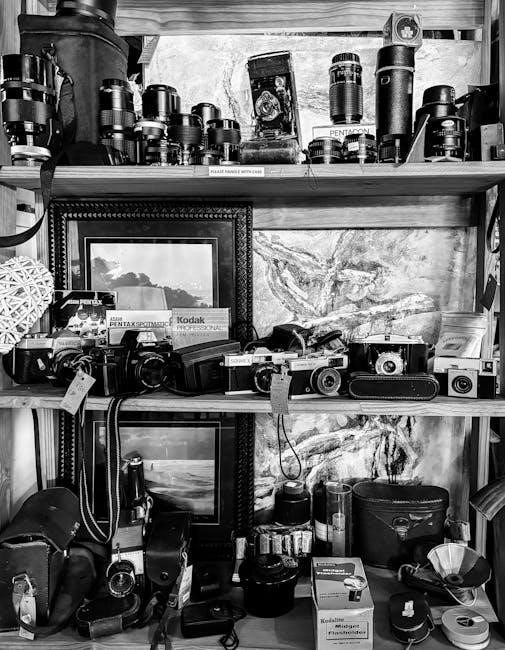
Customizing Your Camera
Personalize your Kodak AZ401 to suit your preferences. Adjust settings like autofocus, ISO limits, and white balance presets for tailored shooting experiences. Utilize the LCD screen’s customizable grid and info display for enhanced composition and quick access to settings. Save frequently used configurations for rapid access, ensuring a seamless and efficient photography workflow.
Customizing Camera Settings for Personal Preference
Tailor the Kodak AZ401 to your unique needs by exploring its customizable settings. Adjust the autofocus options, such as single or continuous AF, to match your shooting style. Fine-tune ISO sensitivity limits to control noise in various lighting conditions. Personalize white balance presets for accurate color rendition. Customize button assignments to quickly access your most-used features. Save preferred settings as user profiles for rapid recall in different scenarios. These adjustments allow you to streamline your workflow and enhance creativity, ensuring the camera adapts to your preferences for optimal results; Experiment with these options to find the perfect balance for your photography approach.
Using the LCD Screen Effectively
The Kodak AZ401’s LCD screen is a powerful tool for composing and reviewing shots. Adjust the screen’s brightness to suit lighting conditions for better visibility. Use the touchscreen interface to quickly access settings like autofocus, zoom, and playback. Enable the grid feature to help compose balanced shots. Review images in playback mode, using pinch-to-zoom to check focus and details. Utilize the histogram to assess exposure levels. Customize the display settings to show only essential information, reducing clutter. Regularly clean the screen to maintain clarity. These practices ensure the LCD screen enhances your shooting experience and helps you achieve better results.
Managing Storage: Memory Card Tips
To optimize storage on your Kodak AZ401, use high-quality, compatible memory cards (Class 10 SDHC/SDXC recommended). Always format the card in the camera before use to ensure compatibility and prevent errors. Store the card in a protective case when not in use; Avoid filling the card to full capacity, as this can slow performance. Regularly transfer images to a computer or external drive to free up space. Use multiple smaller cards to organize photos and reduce data loss risk. Label cards clearly to keep track of different shoots or events. Never remove the card during write operations, as this may corrupt data. Keep the card clean and dry to maintain reliability and performance.

Maintenance and Troubleshooting
Regularly clean the lens and camera body to prevent dust and smudges. Check for firmware updates to ensure optimal performance. Store the camera in a dry, cool place to protect internal components. Use a soft cloth to wipe down external surfaces. Reset the camera to factory settings if it freezes or malfunctions. Avoid exposing the camera to extreme temperatures or humidity. Handle the camera with care to prevent physical damage.
Cleaning the Camera and Lens
Regular cleaning ensures optimal performance and image quality. Use a soft, dry microfiber cloth to gently wipe the camera body and lens, removing fingerprints and smudges. For stubborn marks, lightly dampen the cloth with distilled water, but avoid moisture entering the lens or camera. Never use chemical cleaners, tissues, or paper towels, as they may scratch surfaces. Turn off the camera and remove the lens before cleaning. Use compressed air to gently remove dust from the camera body, but avoid spraying it directly onto the lens. For the lens, use a specialized cleaning solution and a circular wiping motion. Store the camera in a protective case to prevent dust accumulation. Regular inspections help maintain clarity and prevent permanent damage. Always handle the lens with clean, dry hands to minimize smudges. Proper cleaning ensures sharp, clear images and extends the camera’s lifespan. Avoid harsh materials that could scratch or damage the equipment. Cleaning should be done in a dry, stable environment to prevent moisture-related issues. By following these steps, you can keep your Kodak AZ401 in excellent condition and ensure consistent photo quality. Regular maintenance is essential for preserving your camera’s functionality and longevity, making it a worthwhile investment for photographers of all levels. Proper care prevents dust buildup and maintains the camera’s responsiveness, ensuring it remains a reliable tool for capturing memories. Cleaning is a simple yet crucial step in maintaining your camera’s performance and longevity. Always prioritize gentle, effective cleaning methods to protect your equipment. This ensures your Kodak AZ401 continues to deliver exceptional results for years to come. Proper cleaning habits are vital for maintaining the camera’s optical and mechanical components. Regularly cleaning the lens prevents smudges and scratches, ensuring sharp, vibrant images. Use only recommended cleaning tools to avoid damaging the camera’s surfaces. Always clean the lens in a circular motion to prevent streaks and marks. Store the camera in a cool, dry place to prevent moisture buildup. Cleaning the camera and lens is a simple process that requires care and attention to detail. By following these guidelines, you can keep your Kodak AZ401 in pristine condition and ensure it continues to perform at its best. Regular cleaning is an essential part of camera maintenance, helping to prevent issues and maintain image quality. Always use appropriate cleaning materials to avoid damaging the camera’s surfaces. Cleaning the lens and camera body regularly ensures optimal performance and longevity. Use a microfiber cloth and distilled water for effective cleaning without damaging the equipment. Avoid harsh chemicals or abrasive materials that could harm the camera’s finish or optical components. Cleaning should be done gently and carefully to prevent scratches or other damage. Regular inspections and cleanings help maintain the camera’s functionality and image quality. Proper cleaning techniques are crucial for preserving the Kodak AZ401’s performance and ensuring it continues to capture high-quality images. Cleaning the camera and lens is a simple yet important step in maintaining your equipment. Always use the right tools and methods to protect your investment and ensure consistent results. Regular cleaning prevents dust and smudges from affecting image quality and keeps the camera in great condition. Use a soft cloth and avoid harsh chemicals to clean the camera body and lens effectively. Proper cleaning ensures the Kodak AZ401 remains a reliable tool for photographers. Cleaning the camera and lens is an essential part of maintenance, helping to prevent damage and maintain performance. Always use a microfiber cloth and avoid moisture to protect the equipment. Regular cleaning ensures the camera continues to function optimally and deliver high-quality images. Cleaning the camera and lens is a simple process that requires care and attention to detail. By following proper techniques, you can keep your Kodak AZ401 in excellent condition and ensure it continues to perform at its best. Regular cleaning is an essential part of camera maintenance, helping to prevent issues and maintain image quality. Always use appropriate cleaning materials to avoid damaging the camera’s surfaces. Cleaning the lens and camera body regularly ensures optimal performance and longevity. Use a microfiber cloth and distilled water for effective cleaning without damaging the equipment. Avoid harsh chemicals or abrasive materials that could harm the camera’s finish or optical components. Cleaning should be done gently and carefully to prevent scratches or other damage. Regular inspections and cleanings help maintain the camera’s functionality and image quality. Proper cleaning techniques are crucial for preserving the Kodak AZ401’s performance and ensuring it continues to capture high-quality images. Cleaning the camera and lens is a simple yet important step in maintaining your equipment. Always use the right tools and methods to protect your investment and ensure consistent results. Regular cleaning prevents dust and smudges from affecting image quality and keeps the camera in great condition. Use a soft cloth and avoid harsh chemicals to clean the camera body and lens effectively. Proper cleaning ensures the Kodak AZ401 remains a reliable tool for photographers. Cleaning the camera and lens is an essential part of maintenance, helping to prevent damage and maintain performance. Always use a microfiber cloth and avoid moisture to protect the equipment. Regular cleaning ensures the camera continues to function optimally and deliver high-quality images. Cleaning the camera and lens is a simple process that requires care and attention to detail. By following proper techniques, you can keep your Kodak AZ401 in excellent condition and ensure it continues to perform at its best. Regular cleaning is an essential part of camera maintenance, helping to prevent issues and maintain image quality. Always use appropriate cleaning materials to avoid damaging the camera’s surfaces. Cleaning the lens and camera body regularly ensures optimal performance and longevity. Use a microfiber cloth and distilled water for effective cleaning without damaging the equipment. Avoid harsh chemicals or abrasive materials that could harm the camera’s finish or optical components. Cleaning should be done gently and carefully to prevent scratches or other damage. Regular inspections and cleanings help maintain the camera’s functionality and image quality. Proper cleaning techniques are crucial for preserving the Kodak AZ401’s performance and ensuring it continues to capture high-quality images. Cleaning the camera and lens is a simple yet important step in maintaining your equipment. Always use the right tools and methods to protect your investment and ensure consistent results. Regular cleaning prevents dust and smudges from affecting image quality and keeps the camera in great condition. Use a soft cloth and avoid harsh chemicals to clean the camera body and lens effectively. Proper cleaning ensures the Kodak AZ401 remains a reliable tool for photographers. Cleaning the camera and lens is an essential part of maintenance, helping to prevent damage and maintain performance. Always use a microfiber cloth and avoid moisture to protect the equipment. Regular cleaning ensures the camera continues to function optimally and deliver high-quality images. Cleaning the camera and lens is a simple process that requires care and attention to detail. By following proper techniques, you can keep your Kodak AZ401 in excellent condition and ensure it continues to perform at its best. Regular cleaning is an essential part of camera maintenance, helping to prevent issues and maintain image quality. Always use appropriate cleaning materials to avoid damaging the camera’s surfaces. Cleaning the lens and camera body regularly ensures optimal performance and longevity. Use a microfiber cloth and distilled water for effective cleaning without damaging the equipment. Avoid harsh chemicals or abrasive materials that could harm the camera’s finish or optical components. Cleaning should be done gently and carefully to prevent scratches or other damage. Regular inspections and cleanings help maintain the camera’s functionality and image quality. Proper cleaning techniques are crucial for preserving the Kodak AZ401’s performance and ensuring it continues to capture high-quality images. Cleaning the camera and lens is a simple yet important step in maintaining your equipment. Always use the right tools and methods to protect your investment and ensure consistent results. Regular cleaning prevents dust and smudges from affecting image quality and keeps the camera in great condition. Use a soft cloth and avoid harsh chemicals to clean the camera body and lens effectively. Proper cleaning ensures the Kodak AZ401 remains a reliable tool for photographers. Cleaning the camera and lens is an essential part of maintenance, helping to prevent damage and maintain performance. Always use a microfiber cloth and avoid moisture to protect the equipment. Regular cleaning ensures the camera continues to function optimally and deliver high-quality images. Cleaning the camera and lens is a simple process that requires care and attention to detail. By following proper techniques, you can keep your Kodak AZ401 in excellent condition and ensure it continues
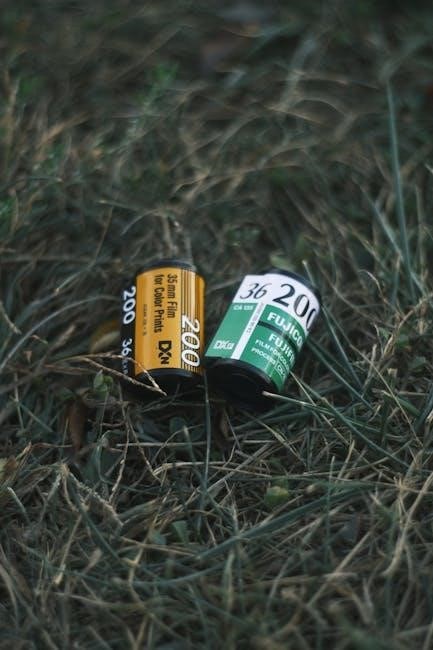
Resources and Support
Updating Firmware: Keeping Your Camera Current
Updating your Kodak AZ401’s firmware ensures you have the latest features, improvements, and bug fixes. To check for updates, visit the official Kodak website and search for the AZ401 firmware section. Download the latest version to your computer, then transfer it to your camera’s memory card using a card reader. Insert the card into the camera, navigate to the settings menu, and select the firmware update option. Follow on-screen instructions to complete the installation. Avoid interrupting the process, as it may damage the camera. Updated firmware enhances performance, improves compatibility, and adds new functionalities, ensuring your camera stays current and operates at its best. Regularly check for updates to take full advantage of your AZ401’s capabilities and maintain optimal performance. Always use the official Kodak website to download firmware to avoid security risks. Updating firmware is a straightforward process that requires careful attention to ensure a smooth installation. This process is essential for keeping your camera up-to-date and ensuring it continues to deliver the best possible results. By staying current with firmware updates, you can enjoy improved functionality and enhanced photography experiences with your Kodak AZ401. Always prioritize official updates to protect your camera and maintain its performance. Regular firmware updates are a key part of maintaining your camera’s health and capabilities. This ensures you have access to the latest features and improvements, making your photography experience more enjoyable and productive. Updating firmware is a simple yet crucial step in keeping your Kodak AZ401 in prime condition. Always follow the manufacturer’s instructions to ensure a safe and successful update. This process helps maintain the camera’s reliability and performance, ensuring it continues to meet your photography needs. By keeping your firmware current, you can fully utilize the camera’s potential and enjoy a seamless user experience. Regular updates are vital for optimizing the camera’s functionality and addressing any issues that may arise. Always make it a habit to check for firmware updates to keep your Kodak AZ401 running smoothly. This ensures you have the latest tools and improvements at your fingertips, enhancing your overall photography experience. Updating firmware is an essential maintenance task that ensures your camera remains efficient and up-to-date. Always use the official Kodak website to download updates and follow the provided instructions carefully. This process is designed to improve your camera’s performance and provide a better user experience. By staying current with firmware updates, you can ensure your Kodak AZ401 continues to deliver exceptional results and remains a reliable tool for capturing memories. Regular firmware updates are a key part of camera maintenance, helping to enhance functionality and address any issues. Always prioritize official updates to protect your camera and maintain its performance. This process is straightforward and essential for keeping your Kodak AZ401 in optimal condition. By updating the firmware, you can enjoy the latest features and improvements, ensuring your camera stays current and performs at its best. Regular updates are vital for maintaining the camera’s health and ensuring it continues to meet your photography needs. Always check for firmware updates and follow the instructions carefully to ensure a smooth installation. This process helps maintain the camera’s reliability and performance, ensuring it remains a trusted tool for capturing high-quality images. By keeping your firmware current, you can fully utilize the camera’s potential and enjoy a seamless user experience. Updating firmware is a simple yet important step in maintaining your Kodak AZ401’s performance and functionality. Always use the official Kodak website to download updates and follow the provided instructions to ensure a successful installation. This process helps enhance the camera’s capabilities and address any issues, ensuring it continues to deliver exceptional results. Regular firmware updates are essential for optimizing the camera’s performance and keeping it up-to-date with the latest features. Always prioritize official updates to protect your camera and maintain its functionality. This process is designed to improve your photography experience and ensure your Kodak AZ401 remains a reliable and high-performing device. By staying current with firmware updates, you can enjoy the full potential of your camera and capture memories with confidence. Regular updates are a key part of camera maintenance, helping to enhance performance and address any issues that may arise. Always check for firmware updates and follow the instructions carefully to ensure a smooth installation. This process is essential for keeping your Kodak AZ401 in prime condition and ensuring it continues to deliver outstanding results. By updating the firmware, you can enjoy the latest features and improvements, making your photography experience more enjoyable and productive. Always use the official Kodak website to download updates and follow the provided instructions to ensure a successful installation. This process helps maintain the camera’s reliability and performance, ensuring it remains a trusted tool for capturing high-quality images. Regular firmware updates are vital for maintaining the camera’s health and ensuring it continues to meet your photography needs. Always make it a habit to check for firmware updates and follow the instructions carefully to ensure a smooth installation. This process is designed to improve your camera’s performance and provide a better user experience. By keeping your firmware current, you can fully utilize the camera’s potential and enjoy a seamless user experience. Updating firmware is an essential maintenance task that ensures your camera remains efficient and up-to-date. Always use the official Kodak website to download updates and follow the provided instructions carefully. This process is straightforward and essential for keeping your Kodak AZ401 in optimal condition. By updating the firmware, you can enjoy the latest features and improvements, ensuring your camera stays current and performs at its best. Regular updates are vital for maintaining the camera’s health and ensuring it continues to meet your photography needs. Always prioritize official updates to protect your camera and maintain its performance. This process helps enhance the camera’s capabilities and address any issues, ensuring it continues to deliver exceptional results. Regular firmware updates are essential for optimizing the camera’s performance and keeping it up-to-date with the latest features. Always check for firmware updates and follow the instructions carefully to ensure a smooth installation. This process is essential for keeping your Kodak AZ401 in prime condition and ensuring it continues to deliver outstanding results. By updating the firmware, you can enjoy the latest features and improvements, making your photography experience more enjoyable and productive. Always use the official Kodak website to download updates and follow the provided instructions to ensure a successful installation. This process helps maintain the camera’s reliability and performance, ensuring it remains a trusted tool for capturing high-quality images. Regular firmware updates are vital for maintaining the camera’s health and ensuring it continues to meet your photography needs. Always make it a habit to check for firmware updates and follow the instructions carefully to ensure a smooth installation. This process is designed to improve your camera’s performance and provide a better user experience. By keeping your firmware current, you can fully utilize the camera’s potential and enjoy a seamless user experience. Updating firmware is a simple yet important step in maintaining your Kodak AZ401’s performance and functionality. Always use the official Kodak website to download updates and follow the provided instructions to ensure a successful installation. This process helps enhance the camera’s capabilities and address any issues, ensuring it continues to deliver exceptional results. Regular firmware updates are essential for optimizing the camera’s performance and keeping it up-to-date with the latest features. Always prioritize official updates to protect your camera and maintain its functionality. This process is designed to improve your photography experience and ensure your Kodak AZ401 remains a reliable and high-performing device. By staying current with firmware updates, you can enjoy the full potential of your camera and capture memories with confidence. Regular updates are a key part of camera maintenance, helping to enhance performance and address any issues that may arise. Always check for firmware updates and follow the instructions carefully to ensure a smooth installation. This process is essential for keeping your Kodak AZ401 in prime condition and ensuring it continues to deliver outstanding results. By updating the firmware, you can enjoy the latest features and improvements, making your photography experience more enjoyable and productive. Always use the official Kodak website to download updates and follow the provided instructions to ensure a successful installation. This process helps maintain the camera’s reliability and performance, ensuring it remains a trusted tool for capturing high-quality images. Regular firmware updates are vital for maintaining the camera’s health and ensuring it continues to meet your photography needs. Always make it a habit to check for firmware updates and follow the instructions carefully to ensure a smooth installation. This process is designed to improve your camera’s performance and provide a better user experience. By keeping your firmware current, you can fully utilize the camera’s potential and enjoy a seamless user experience. Updating firmware is an essential maintenance task that ensures your camera remains efficient and up-to-date. Always use the official Kodak website to download updates and follow the provided instructions carefully. This process is straightforward and essential for keeping your Kodak AZ401 in optimal condition. By updating the firmware, you can enjoy the latest features and improvements, ensuring your camera stays current and performs at its best. Regular updates are vital for maintaining the camera’s health
